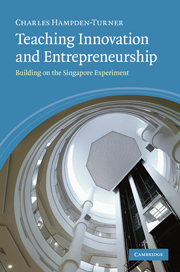Book contents
- Frontmatter
- Contents
- List of grids
- List of dilemmas
- Acknowledgements
- Introduction
- 1 Singapore’s challenge
- 2 The entrepreneurial ecosystem
- 3 How can innovative pedagogies be measured?
- 4 Co-defining innovative education
- 5 The Singapore results
- 6 Results of the Mandarin-speaking programme
- 7 Reconciling values
- 8 ‘It is only the Hawthorne Effect’
- 9 The programme that cannot stand still
- 10 Innovation and the future of the university
- 11 What are the implications of being able to teach innovation?
- 12 Is a new creative class arising?
- Notes
- Bibliography
- Appendices
- General index
- Index of dilemmas and reconciliations
6 - Results of the Mandarin-speaking programme
Published online by Cambridge University Press: 05 July 2014
- Frontmatter
- Contents
- List of grids
- List of dilemmas
- Acknowledgements
- Introduction
- 1 Singapore’s challenge
- 2 The entrepreneurial ecosystem
- 3 How can innovative pedagogies be measured?
- 4 Co-defining innovative education
- 5 The Singapore results
- 6 Results of the Mandarin-speaking programme
- 7 Reconciling values
- 8 ‘It is only the Hawthorne Effect’
- 9 The programme that cannot stand still
- 10 Innovation and the future of the university
- 11 What are the implications of being able to teach innovation?
- 12 Is a new creative class arising?
- Notes
- Bibliography
- Appendices
- General index
- Index of dilemmas and reconciliations
Summary
Instructing Chinese students from the PRC in Mandarin turned out to be a very different experience from instructing Singaporeans and others in English. Professor Tan experienced them both since he is bilingual, a rare advantage in modern Singapore, where many elite Singaporeans have lost their native tongue. Professor Clayton Christiansen, this author and several other faculty members had their presentations translated into Mandarin by Tan Teng-Kee, a somewhat exhausting process for him. Both programmes included the ‘ecosystem’ described in Chapter 2 with visits to the USA and China. The two classes met and mingled.
Those teaching both classes quickly noticed some differences. Here is a summary of our earlier impressions.
The Chinese students had few, if any, of the inhibitions against showing off and attracting attention to themselves that characterized the Singaporean class. The Chinese were more extravagant and playful, and preferred to talk rather than listen.
They took much longer to achieve membership of a coherent team. Both we and the Chinese themselves attributed this to the ‘one child per family’ policy of the PRC. This one child has two parents, four grandparents, usually no siblings and is the centre of adult attention. They are treated like ‘Little Emperors or Empresses’. They lack interaction with peers.
Chinese students were much more likely to have studied ‘soft’ subjects, the liberal arts, humanities and social sciences. These have been relatively neglected in Singapore in favour of teaching business, science and engineering. …
- Type
- Chapter
- Information
- Teaching Innovation and EntrepreneurshipBuilding on the Singapore Experiment, pp. 94 - 106Publisher: Cambridge University PressPrint publication year: 2009



